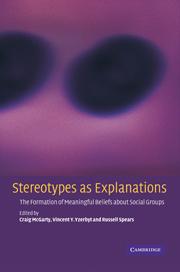Book contents
- Frontmatter
- Contents
- List of figures
- List of contributors
- Preface
- 1 Social, cultural and cognitive factors in stereotype formation
- 2 Stereotype formation as category formation
- 3 Subjective essentialism and the emergence of stereotypes
- 4 The role of theories in the formation of stereotype content
- 5 Illusory correlation and stereotype formation: making sense of group differences and cognitive biases
- 6 Dependence and the formation of stereotyped beliefs about groups: from interpersonal to intergroup perception
- 7 Four degrees of stereotype formation: differentiation by any means necessary
- 8 From personal pictures in the head to collective tools in the world: how shared stereotypes allow groups to represent and change social reality
- 9 Conclusion: stereotypes are selective, variable and contested explanations
- References
- Author index
- Subject index
1 - Social, cultural and cognitive factors in stereotype formation
Published online by Cambridge University Press: 22 September 2009
- Frontmatter
- Contents
- List of figures
- List of contributors
- Preface
- 1 Social, cultural and cognitive factors in stereotype formation
- 2 Stereotype formation as category formation
- 3 Subjective essentialism and the emergence of stereotypes
- 4 The role of theories in the formation of stereotype content
- 5 Illusory correlation and stereotype formation: making sense of group differences and cognitive biases
- 6 Dependence and the formation of stereotyped beliefs about groups: from interpersonal to intergroup perception
- 7 Four degrees of stereotype formation: differentiation by any means necessary
- 8 From personal pictures in the head to collective tools in the world: how shared stereotypes allow groups to represent and change social reality
- 9 Conclusion: stereotypes are selective, variable and contested explanations
- References
- Author index
- Subject index
Summary
The purpose of this book
Imagine for a moment a busy city intersection with a police officer controlling traffic. All of the users of that street are individuals, but they are also members of society and, like the police officer they are members of groups that help us to explain why those people act in the way they do at particular times. Indeed, individuals and groups can be said to be the central facts of society. Without individuals there could be no society, but unless individuals also perceive themselves to belong to groups, that is, to share characteristics, circumstances, values and beliefs with other people, then society would be without structure or order. These perceptions of groups are called stereotypes.
If we accept that perceptions of groups are so important for people to understand the social world, then understanding those stereotypes is also extremely important for social psychology. Social psychologists such as Asch (1952) have argued that understanding the relationship between individuals and groups is the master problem for social psychology. In addressing this problem we need to recognize though, that individuals and groups tend to have their effects on each other through their psychological representation within individual minds. That is, social objects affect us through the way they are perceived rather than through the application of physical force.
Think again of the police officer controlling traffic at a busy intersection. The police officer does not (normally) need to physically restrain the traffic from passing through the intersection.
- Type
- Chapter
- Information
- Stereotypes as ExplanationsThe Formation of Meaningful Beliefs about Social Groups, pp. 1 - 15Publisher: Cambridge University PressPrint publication year: 2002
- 35
- Cited by



